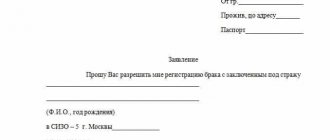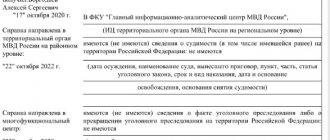Criminal Code of the Russian Federation in the latest edition:
Article 6 of the Criminal Code of the Russian Federation. Principle of justice
1. Punishment and other measures of a criminal legal nature applied to a person who has committed a crime must be fair, that is, correspond to the nature and degree of public danger of the crime, the circumstances of its commission and the identity of the perpetrator.
2. No one can be criminally liable twice for the same crime.
Return to the table of contents of the document: Criminal Code of the Russian Federation in the latest edition
Commentary to Art. 6 of the Criminal Code
1. Justice is a category of ethical, moral and socio-legal nature. In criminal law, the principle of justice is addressed equally to the legislator and the law enforcer. Accordingly, in order for a court considering a particular case to impose a fair punishment, the legislator must determine a fair sanction for an act that is prohibited by law.
2. The legislator, establishing a sanction, gives the court the opportunity to individualize the punishment within the boundaries assigned to it. Therefore, in the Criminal Code, most sanctions are alternative and relatively specific, which gives the right to choose one or another type of punishment, and within the framework of one punishment, upper and lower limits are indicated.
3. The measure of fairness of punishment in each specific case is chosen by the court, taking into account the severity of the act committed, circumstances mitigating and aggravating the punishment (Articles 61, 63 of the Criminal Code), positive and negative qualities of the personality of the perpetrator.
4. Given in Part 2 of Art. 6 of the Criminal Code, the provision is based on Part 1 of Art. 50 of the Constitution of the Russian Federation. Citizens of the Russian Federation and stateless persons permanently residing in the Russian Federation who have committed a crime outside the Russian Federation are not subject to criminal liability if in relation to these persons there is a court decision of a foreign state regarding this crime (Part 1 of Article 12 of the Criminal Code).
Second commentary to Art. 6 of the Criminal Code of the Russian Federation
1. There are two aspects to justice: egalitarian (equalizing justice) and differentiating (distributive justice). The first presupposes the initial equality of all citizens before the law, the second - the individualization of punishment. The distributive aspect of justice is reinforced in the article under comment.
2. The Criminal Code contains a number of provisions aimed at ensuring fair punishment. First of all, these are the general principles of sentencing enshrined in the criminal law, as well as the conditions for sentencing when the jury verdicts on leniency, for an unfinished crime, for a crime committed in complicity, etc.
The appointment of a fair punishment is ensured by a fairly wide list of its types, the legislative formulation of criminal sanctions, etc.
3. Part 2 of the commented article essentially reproduces Art. 50 of the Constitution of the Russian Federation: no one can be held criminally liable twice for the same crime.
How to fill out the new 6-NDFL
The calculation consists of:
- title page;
- section 1;
- section 2;
- Appendix No. 1, which is a certificate of income.
Moreover, sections 1, 2 and Appendix are filled out for each personal income tax rate separately.
When filling out the title page you must indicate:
- INN/KPP. Individual entrepreneurs put dashes instead of checkpoints.
- The adjustment number is entered if an updated calculation is submitted; for the primary calculation, “0—” is entered.
- Reporting period code. Since we are talking about 6-personal income tax for 2021, we put the code “34” .
- Calendar year. In our case - “2021”.
- Code of the tax office to which the calculation is submitted.
- Code at the location/registration of the employer.
For example: “ 214 ” - at the place of registration of the Russian - at the place of residence of the individual entrepreneur.
- Name of the organization or full name of the entrepreneur. Moreover, the name is indicated in abbreviated form or in full, if the abbreviated name was not indicated when registering the company. But the full name of the entrepreneur - only in full.
- OKTMO code. If OKTMO has 8 characters rather than 11, then we leave the remaining cells empty; there is no need to put dashes .
- Contact phone number.
- Number of pages in the calculation and applications.
For example, if 6-NDFL is signed by a representative of a tax agent, then the number of sheets of attachments must include the number of sheets of power of attorney.
You can find out the tax code and OKTMO in a special service on the website of the Federal Tax Service for legal entities. company address or individual entrepreneur’s place of residence.
And then - information about who signs the report: “1” - tax agent (full name of the responsible person) or “2” - representative (name of the representative organization or full name of the representative individual). As well as the date the report was signed and the signature of the responsible person. If the report is submitted via EDI, then an electronic signature.
In this article we will not talk about fields for a liquidated or reorganized company. Since they enter other codes for the reporting period, as well as additional fields, for example, “TIN/KPP of the reorganized organization.”
Submit reports to the tax office, fund and Rosstat through the Online Sprinter service. Use the service for free for a whole month and appreciate all its benefits.
Completing Section 1
This section contains information on income and personal income tax for the fourth quarter of 2021. In the fields of the section we indicate:
- 010 — KBK. For 2022 and in 2022, the tax agent indicates one of two BCCs for ordinary income (salaries, GPC agreements):
With a tax base of up to 5 million rubles. inclusive (rate 13%) - 18210102010011000110.
With a tax base of over 5 million rubles. (rate 15%) - 18210102080011000110.
- 020 — personal income tax transferred for the last three months;
- 021 — tax payment deadline;
For wages, this is the next working day after the payment of wages. For sick leave and vacation pay - the last day of the month in which they were paid.
- 022 — personal income tax amount. For each payment for which different dates are set, you need to fill out separate fields 021 and 022;
- 030 — personal income tax returned to employees in the fourth quarter (the employer can return tax amounts when applying a deduction for children for past periods or a property deduction based on a notification from the Federal Tax Service);
- 031 - return date;
- 032 — the amount of personal income tax returned.
What to do with Section 1 if different personal income tax rates were applied to income during the year? The Federal Tax Service in a letter dated September 17, 2021 No. BS-4-11/ [email protected] responded that in this case it is necessary to fill out a separate section for each tax rate (for example, 13% and 15%), since different ones apply for each KBK.
Completing Section 2
This section indicates the total amounts of income, individuals, deductions, etc., the section is filled in with a cumulative total from the beginning of the year. In fields 100 and 105 we indicate the personal income tax rate and the corresponding BCC.
If the company had personal income tax payments of 13% and 15%, then a separate Section 2 is filled out for each rate.
Next, in fields 110-115 the total amounts of payments to all individuals are entered, broken down by type of income:
- under employment contracts;
- then GPC agreements;
- under GPC agreements with highly qualified specialists (HQS);
- dividends.
In fields 120-121 - the number of individuals, including HQS, who were paid income both in the form of wages and as remuneration under civil contracts. And in field 130 - tax deductions for all employees in the total amount.
Fields 140-190 are intended exclusively for personal income tax amounts:
- 140 — calculated tax, including the December salary (and it does not matter when it was paid, since the accrual date is the last day of the month).
- 141 — calculated only from dividends;
- 142 — calculated from the amounts paid to the HQS;
- 160 - withheld tax. If the salary for December was paid in January, then personal income tax on the December salary is not included in this amount;
- 170 — tax that the employer or customer could not withhold in relation to individuals;
For example, an employer gave gifts to all employees in the amount of more than 4 thousand rubles, including those on maternity leave. But they do not receive any income from the employer, so it was not possible to withhold personal income tax.
- 180 — Personal income tax that was excessively withheld from employees, but was not returned. For example, an employee brought an application for registration of a property deduction from the beginning of the year, which served as the basis for the recalculation of personal income tax, which was previously transferred;
- 190 - tax refunded upon application.
Fill out Appendix No. 1 to 6-NDFL
In fact, the application is a certificate of income of individuals - employees and performers under the GPA. For each person who received income from the company, a separate certificate must be filled out.
First of all, you need to fill out information about the certificate itself and the recipient of the income (Section 1 of the certificate):
- reference number and correction number, if available. For the first calculation we enter “00”. If the certificate is cancelled, then “99”;
- Full name, tax identification number and date of birth of the individual. faces;
- tax status. For example, code “1” is for tax residents, and code “2” is for non-residents;
- country of citizenship code, for Russia - “643”;
- ID document code and its details. For example, a passport of a citizen of the Russian Federation, then we put the code “21”, and if a foreign passport - “10”. And then - the series and number.
Next, you should fill out the application to the certificate. Moreover, if the same individual used different personal income tax rates for the year, then a separate application must be filled out for each of them. For example, if an employee’s income exceeds 5 million rubles. in a year.
We enter the tax rate, BCC and by month we enter the code of the income received (for salary - “2000”, for vacation pay - “2012”, for gifts - “2720”, for bonuses - “2002”) and its amount, as well as the deduction code for Personal income tax (for example, “501” is a deduction from the cost of a gift, “508” is from the amount of one-time assistance for the birth of a child) and the amount.
Standard and social deductions (for a child, treatment or when buying a home) are not included in this section, since they must be indicated in Section 3 of the Appendix.
In section 3 of the certificate, we indicate standard, social and property deductions in the total amount for the entire year (“126” is a deduction for the first child, “311” is a deduction for purchasing a home or “320” is a deduction for education).
If the employer received a notification directly from the Federal Tax Service about a tax deduction for an employee, then its type, number, date of issue and inspection code are indicated below. The notification type code can be as follows:
“1” - property;
“2” - social;
“3” - reduction of personal income tax for fixed advance payments.
Next, fill out section 2 of the help . In it we indicate:
- personal income tax rate and the corresponding BCC;
- the amount of payments for the year (total) without reduction for deductions and personal income tax;
- tax base, that is, income reduced by deductions;
- calculated, withheld and transferred, including excess, personal income tax.
If necessary, fill in information about the foreigner’s fixed advance payments.
And the last one is section 4 . It is filled out if the employer or customer was unable to withhold personal income tax under the GPA. First, the full amount of income is indicated, and then the tax itself.
Third commentary to Article 6 of the Criminal Code of the Russian Federation
1. Justice is not only and not so much a moral and ethical category that characterizes the relationship between the measure of good and evil, the citizen’s value judgment about this measure. Justice is a universal category, one might say, comprehensive, permeating all aspects of social relations. In law in general and in criminal law in particular, it finds a peculiar refraction, since all its norms must correspond to the principles of justice and morality. A norm of law devoid of these principles is no longer a legal norm in its very essence. Such a “norm” can no longer fulfill any of its inherent functions. Justice is inherent in the normative material from the very beginning; it seems to be “spread” throughout its entire content. That is why the elevation of justice to the principle of criminal law and its enshrinement in Art. 6 of the Criminal Code of the Russian Federation is an expression in the law itself of one of the guiding principles that together form the foundation on which the entire edifice of Russian criminal legislation is based.
2. Part 1 art. 6 of the Criminal Code of the Russian Federation, in essence, reduces the principle of justice to the appointment of a person found guilty of committing a crime, a fair punishment or other measures of a criminal law nature that would correspond to the nature and degree of public danger of the act, the circumstances of its commission and the identity of the perpetrator. Undoubtedly, imposing a proportionate punishment or other measures of a criminal legal nature on a citizen, i.e. such compulsory measures of state legal coercion, which are fully consistent with the gravity of the crime, is the most typical and, apparently, the most important form of manifestation of the principle of justice in criminal law and the practice of applying its norms. However, this is far from the only such form. An analysis of the new criminal legislation regarding the manifestation of the principle of justice in it allows us to identify and outline other forms, without touching on what is enshrined in Part 2 of Art. 6 of the Criminal Code stipulates that no one can be held criminally liable twice for the same crime. This rule is known to Roman law (“non bis in idem”).
3. Along with the principles commented above, the principle of fairness in criminal law, enshrined in Art. 6 of the Criminal Code of the Russian Federation, has other forms of manifestation. These, in particular, include: the determination by the legislator of the minimum necessary range of socially dangerous acts classified as crimes (the process of criminalization); timely and justified exclusion from it of acts that can be combated by other measures and means (decriminalization process); establishing in the sanctions the articles of the Special Part of the Criminal Code regarding the exact correspondence between the severity (nature and degree of public danger) of the crime and the degree of severity of the punitive sanction; designing the type of sanctions themselves, while giving preference to alternative, relatively specific sanctions, taking into account the reasonable establishment of the limits of the discretionary powers of the court when imposing punishment on the perpetrator; implementation of the principle of saving criminal repression into legislation; imposing a more lenient punishment than provided for by law for this crime (Article 64); imposition of punishment upon the jury's verdict of leniency (Article 65); suspended sentence (Article 73); the institution of exemption from criminal liability (Chapter 11, Art. 75 - 78); institution of exemption from punishment (Chapter 12, Art. 79 - 83).
The mentioned and many other provisions of the new Criminal Code of the Russian Federation significantly strengthen the principles of justice of the criminal law, raised by the legislator to the highest level as one of the basic principles of this branch of Russian law.
‹ Article 5. The principle of guiltUp Article 7. The principle of humanism ›
How to check control ratios when filling out 6-NDFL
First, check the basic rules for filling out the calculation itself:
- the amount of tax deductions (field 130) should not exceed the amount of income (field 110);
- field 150 is filled in only if a special notification has been received from the tax office about the possibility of reducing personal income tax on fixed advance payments of a foreigner;
- field 140 = (field 110 - field 130) / 100 * field 100. If this equality is incorrect, then you should check the tax base, deductions and personal income tax amount - there is an error somewhere there.
- field 120 (the number of individuals who received income from the company) must be equal to the number of certificates drawn up at the same personal income tax rate;
- the total amount of income paid in section 2 (field 110) is equal to the amount of income for all individuals in the certificates. The amounts of deductions and personal income tax are checked in the same way.
Reconciliation with RSV
Some amounts from 6-NDFL can be compared with amounts based on insurance premiums.
For example, the number of employees in 6-NDFL and in the third section of the DAM must be the same. In addition, the amounts of payments to individuals must match the amount in fields 112 and 113 of Section 2 of 6-NDFL and those indicated in the RSV in field 050 of Appendix 1. Otherwise, tax authorities may consider that one of the reports understates the tax base.
You can also compare employee incomes with the minimum wage and the industry average salary in the region. Otherwise, the Federal Tax Service will send a notice of discrepancy.
Although, if the company has not violated anything, for example, the salary is below the industry average, since the company is completely new, and the salary is less than the minimum wage, since the employee works at 0.5 times the rate, then there will be no problems. But tax authorities will still pay attention to this and demand an answer.
In addition, it is important to check the amounts of personal income tax paid against the accounting registers so that there are no delays in tax payment or errors in the amount.








